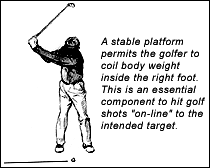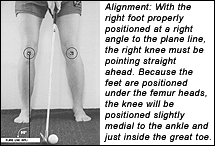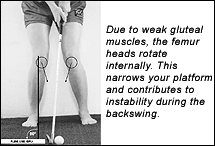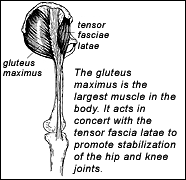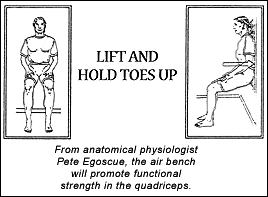A stable platform is made of three components: proper alignment of the right knee over the right ankle, functional gluteal muscles, and strong quadriceps.
The Gluteal Muscles
If you imagine the kneecaps as headlights on your car, they will aim straight ahead as long as the gluteus maximus is functional. When weak, the femur heads will rotate internally, and your "headlights" will cross.
Clinical Examination: Have your patient stand with feet pointing straight ahead and fingertips placed over the gluteus maximus. Ask the patient to make a hard gluteal contraction. Do not let the patient recruit the quadriceps or abdominal muscles. Many patients will be unable to isolate and contract their gluteal muscles. When done correctly, the patient will experience external rotation of the kneecaps.
Correction Protocol: Have the patient perform 30-50 standing gluteal contractions each day. Have the patient continue until the gluteal muscles are capable of making a strong contraction that rotates the femur heads externally.
The Quadriceps
When your patient reaches the top of the back swing, 75 percent of the body weight has been transferred onto the right quadriceps. If the quadriceps are weak, your patient will not be able to hold the coil. Golfers who walk (rather than using a golf cart), will cover about four miles on a typical golf course and "backswing" their body weight onto the quadriceps about 100 times, including practice swings. Therefore, the quads need to be firm, fit and functional to play good golf.
Clinical Examination: Have your patient place his heels against the baseboard of a wall. Next, move both feet outward to the length of the right foot. Make sure the feet are positioned hip-width apart. Have the patient slowly bend the knees until the patient can't see the tips of his toes. Once in position, have the patient lift his toes off the floor. If your patient has functional quadriceps, he should be able to hold this position for three minutes.
Correction Protocol: Have your patient perform the air bench daily until he or she can hold the position for three to five minutes with no discomfort.
Conclusion
When your patients are at the top of their backswing they must be able to coil against stable platforms. This requires proper position of the right knee over the right ankle as the body weight coils inside the right foot. The knee position is linked to the function of the gluteus maximus. To hold the coil with stability, the quadriceps must be functional.
(My next article will emphasize how swinging on balance is the key to prevention of repetitive strain syndromes.)
Jeffry Blanchard,DC
Encinitas, California
www.blanchardgolf.com
Dr. Jeff Blanchard is a practicing chiropractor who competes as a golf professional. He is the author of The PGA Professionals' Golf Injury Desk Reference (2007). For questions or comments regarding this article, contact Dr. Blanchard at 805-772-8298 or .





